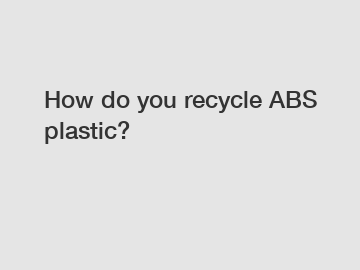How do you recycle ABS plastic?
In today's world, where environmental concerns are of paramount importance, implementing sustainable practices has become crucial. Recycling plastic waste plays a pivotal role, and ABS plastic is no exception. ABS (Acrylonitrile Butadiene Styrene) is a versatile and widely-used plastic that finds its applications in various industries. In this blog post, we will explore the methods and importance of recycling ABS plastic, paving the way for a more sustainable future.
Understanding ABS Plastic: .
ABS plastic is known for its toughness, impact resistance, and ability to withstand high temperatures. Its versatility makes it a preferred choice in manufacturing a wide range of products, such as automotive parts, electronic housings, toys, and home appliances. While ABS is highly durable, it also has a long decomposition period, emphasizing the significance of recycling it.

The Importance of Recycling ABS Plastic: .
1. Conservation of Resources: Recycling ABS plastic helps conserve valuable resources and reduces the need for virgin plastic production. By recycling this durable material, we extend its lifespan, leading to a more sustainable approach in the manufacturing industry.
2. Diverting from Landfills: ABS plastic takes an extremely long time to decompose, sometimes even centuries. By recycling it, we divert a significant amount of plastic waste from landfills, reducing the environmental impact.
3. Reduction in Carbon Emissions: Manufacturing new plastic products from virgin materials requires substantial energy consumption and releases significant carbon emissions. Recycling ABS plastic significantly reduces the carbon footprint associated with its production, contributing to combating climate change.
Methods of Recycling ABS Plastic: .
1. Mechanical Recycling: One of the most common methods of recycling ABS plastic is mechanical recycling. In this process, plastic waste is sorted, shredded, and melted to produce new ABS plastic products. Mechanical recycling is ideal for producing items with lower-grade requirements, such as plastic lumber or automotive components.
2. Chemical Recycling: Chemical recycling, also known as feedstock recycling, offers an alternative approach to recycling ABS plastic. This method involves breaking down the plastic into its original chemical constituents, which can then be used as raw materials to create new plastics or other useful products. Chemical recycling enables a closed-loop system, reducing dependence on fossil fuels and ensuring a more sustainable material cycle.
3. 3D Printing Filament Recycling: With the rise of 3D printing, recycling ABS plastic becomes even more crucial. 3D printing filament made from ABS plastic can be recycled by collecting discarded prints, shredding them, and extruding them into new filament for future use. This closed-loop recycling approach helps conserve resources, reduces waste, and fosters a circular economy within the 3D printing industry.
The Role of Advanced Technologies: .
Advanced technologies play a significant role in enhancing recycling processes for ABS plastic. Innovations like artificial intelligence (AI) and machine learning enable more efficient sorting of plastic waste, ensuring higher recycling rates. Additionally, developments in chemical recycling techniques allow for the recovery of even more complex plastics, including ABS, which further strengthens the sustainability of the recycling process.
Promoting ABS Plastic Recycling: .
Individuals, corporations, and governments all have a vital role to play in promoting ABS plastic recycling. Here are a few ways to contribute:
1. Education: Raising awareness about the importance and methods of recycling ABS plastic is crucial. By sharing knowledge and information, we can encourage individuals and businesses to make conscious choices that support a circular economy.
2. Infrastructure Investments: Governments and organizations must invest in recycling facilities that can handle ABS plastic waste. This ensures a streamlined and efficient recycling process, paving the way for a more sustainable future.
3. Collaborations and Partnerships: Encouraging collaborations between plastic manufacturers, recyclers, and end-users can help create a closed-loop system for recycling ABS plastic. By establishing partnerships, we can ensure the smooth flow of materials, making recycling economically viable and environmentally beneficial.
Conclusion: .
Recycling ABS plastic is an essential step towards a sustainable future. By conserving resources, diverting waste from landfills, reducing carbon emissions, and promoting advanced technologies, we can create a circular economy where ABS plastic holds immense value. Let us all embrace recycling as the key to a greener future and work collectively to shape a world that values sustainability and environmental well-being.
For more tire shredder equipment, Hard Plastic Crusher For Sale, pet bottle washing lineinformation, please contact us. We will provide professional answers.


